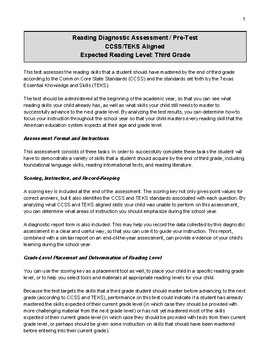Third (3rd) Grade Reading Diagnostic Assessment (CCSS /TEKS) Reading Level Test
- PDF
What educators are saying
Description
This is a diagnostic reading assessment appropriate for use with third grade aged children. It is aligned to the Common Core State Standards (CCSS) and to the required reading skills identified by the Texas Essential Knowledge and Skills (TEKS).
The test can be used as a beginning-of-the-year diagnostic reading assessment to establish a baseline of knowledge that a student already has, and help you target your instruction toward the skills the student still needs to develop. It will indicate whether your child is reading at, above, or below their expected grade level.
This test can also be used to determine what reading level texts would be appropriate for your child. A reading level comparison chart is included with at the end of the test to help you convert their current grade-level (as established by this assessment) with reading levels identified by several different scales (Accelerated Reader Level, Guided Reading Level, Lexile, and Developmental Reading Assessment Level).
Written passages are either original or taken from the public domain. Images are public domain images from Pixaby.com.





